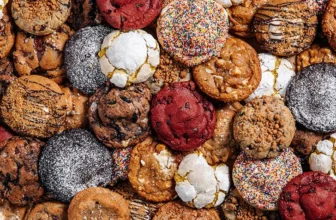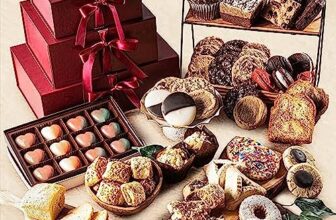
Ah, the sweet smell of freshly baked cookies wafting through the air—who can resist that? But let’s face it, not all cookies are created equal, and Mrs. Fields’ recipe is nothing short of legendary. Whether you’re a baking newbie still mastering the art of mixing flour without creating a cloud of chaos, or a seasoned pro looking to elevate your cookie game, understanding the role of each ingredient will unlock the secrets behind these delightful treats. In this post, they’ll dive deep into the essential components of Mrs. Fields‘ recipe, exploring how each ingredient plays its part in creating that perfect balance of flavor, texture, and warmth. So grab your apron, because it’s time to demystify the magic of cookie-making, one ingredient at a time!
The Foundation: Flour
Ah, flour—the unsung hero of the kitchen! While cookies might get all the glory, let’s take a moment to appreciate flour: the quiet backbone that brings structure and texture to our beloved treats. Mrs. Fields has quite the magical cookie recipe that harnesses the potential of flour in a way that would make even a stand-up comedian jealous of its perfect balance. Let’s dig in!
The Different Types of Flour
Flour comes in various types, each bringing its own unique flair to your cookie recipe. Here’s a quick overview of the most common types you might encounter in Mrs. Fields’ cookie journey:
- All-Purpose Flour
The classic! This is the workhorse of the kitchen and ideal for most cookie recipes. Brands like King Arthur Flour and Gold Medal produce excellent all-purpose flour that works well in a variety of cookies. - Bread Flour
High in protein, bread flour provides extra chew and structure. It’s great for those who want a more robust, bakery-style cookie. If you’re feeling ambitious, try the Bob’s Red Mill Organic Bread Flour. - Cake Flour
Super fine and low in protein, cake flour makes cookies softer and tenderer, perfect for melt-in-your-mouth creations. The Swans Down Cake Flour is a fantastic choice for when you want a lighter cookie. - Whole Wheat Flour
For a nuttier flavor and a health kick, whole wheat flour is your go-to. King Arthur Whole Wheat Flour provides a great texture without compromising on taste.
Understanding Gluten Formation
Now, let’s chat about gluten. If flour is the backbone of cookies, then gluten is the structure within that backbone. Gluten forms when flour is mixed with water (or, you know, butter, sugar, and eggs) and gives elasticity to the dough. Here are some key points to remember:
- More Gluten = Chewy Cookie
If you want a cookie that gives you a good chew, opt for bread flour. The higher protein content leads to more gluten formation! - Less Gluten = Tender Cookie
For a soft and delicate cookie, stick with cake flour or all-purpose flour. They have less protein, meaning less gluten and more tenderness.
Here’s a quick comparison:
| Type of Flour | Protein Content (%) | Best For |
|---|---|---|
| All-Purpose Flour | 10-12 | Versatile cookie recipes |
| Bread Flour | 12-14 | Chewy, bakery-style cookies |
| Cake Flour | 7-9 | Soft, tender cookies |
| Whole Wheat Flour | 13-15 | Nutty, hearty cookies |
Selecting the Right Flour
Choosing the right flour can make or break your cookie game. Here’s how to select the right flour for the desired outcome of your cookies:
- Texture Preference:
- For crunchy cookies, opt for all-purpose or whole wheat flour.
- For chewy cookies, stick with bread flour.
- For soft and cake-like cookies, go for cake flour.
- Flavor Profile:
- Whole wheat adds a nutty flavor, perfect if you’re feeling health-conscious yet indulgent.
- Vanilla cookies pair lovely with all-purpose for a neutral base.
Measuring Flour Like a Pro
One of the most common pitfalls in baking is inaccurate flour measurement. Too much flour can lead to dry, dense cookies that could double as doorstops. Here are some foolproof ways to measure flour accurately:
- Spoon and Level Method:
- Use a spoon to scoop flour into your measuring cup.
- Then, use a straight edge (like the back of a knife) to level it off.
- Weight Measurement:
- Invest in a good kitchen scale— A cup of all-purpose flour weighs about 120 grams. Weighing the flour ensures precision, which is especially helpful when following Mrs. Fields’ recipe.
- Avoid the Scoop:
- Don’t scoop flour directly from the bag with your measuring cup! You’ll end up with a compacted mess.
So, there you have it! Flour is the foundation of great cookies, and by choosing the right type and measuring it correctly, you can create a cookie that’s worthy of both praise and possibly a cookie award (if such a thing existed). Get ready to churn out batches of Mrs. Fields’ like cookies that will have everyone coming back for seconds! 🍪
Sweetness Factor: Sugars
When it comes to baking cookies, sugar isn’t just a sweetener; it’s the magical ingredient that can turn a good cookie into a great one. Think of sugar as the diva of the baking world: it adds sweetness, inspires texture, and bestows that beautiful golden-brown color we’re all yearning for on those cookie sheets. Let’s dive into the major sugar players in your cookie recipe and understand how each type shapes your sweet creations!
Granulated Sugar: The All-Star Sweetener
Granulated sugar is the classic go-to in cookie recipes. Quick to dissolve and readily available, this sugar type plays a significant role in similar cookie varieties. But it’s not just about sweetness; it contributes to the structure and texture of your cookies.
- Texture: Granulated sugar helps achieve a crisp edge while keeping that gooey center (hello, cookie dough happiness!).
- Color: During baking, granulated sugar caramelizes, leading to a delightful golden-brown hue.
- Example Brand: Domino Granulated Sugar is a fantastic choice: it’s pure, reliable, and gives you consistent results.
Brown Sugar: The Flavorful Companion
Brown sugar, the hipster of the sugar world, is simply white sugar with molasses added. Not only does it add moisture and chewiness to cookies, but it also infuses that rich, almost caramel-like flavor that’s simply divine.
- Texture: Brown sugar accelerates moisture retention, making your cookies soft and chewy. Thanks, molasses!
- Flavor: The deeper flavor profile of brown sugar can elevate classic chocolate chip cookies from ordinary to extraordinary.
- Example Brand: C&H Brown Sugar offers great quality and is perfect for baking, providing that extra depth in flavor.
Powdered Sugar: The Secret Weapon
Also known as confectioner’s sugar, this fine sugar is often overlooked but works wonders, especially when making cookie icings or the beloved “dusting” on pastries. While powdered sugar doesn’t often stand alone in cookie recipes, its contributions to toppings and fillings are invaluable.
- Texture: Powdered sugar can create a delightful melt-in-your-mouth effect when sprinkled on cookies.
- Icing Usage: It’s essential for making royal icing for decorating cookies beautifully.
- Example Brand: Wholesome Organic Powdered Sugar is top-notch. It’s made with high-quality, organic ingredients—delicious and guilt-free!
The Science of Sweetness: Maillard Reaction and Caramelization
Now, let’s sprinkle in some science! When baking cookies, two key reactions can occur: the Maillard reaction and caramelization.
Maillard Reaction
This magical reaction happens when you heat sugars and proteins together. It’s responsible for those deliciously complex flavors and colors in baked goods.
- Temperature Trigger: Typically occurs between 300°F to 500°F (150°C to 260°C).
- Taste Impact: Creates a range of flavors from nutty to savory, enhancing the overall cookie experience.
Caramelization
Caramelization is a specific sugar process where sugar is heated at high temperatures, transforming it into golden, toasty goodness. You can think of it as sugar’s glam party!
- Sugar Type: Mostly involves granulated sugars (but brown sugar can caramelize too!).
- Sweetness Boost: Heightens sweetness and adds a deeper, more complex flavor to cookies.
Sugar Comparison Table
| Sugar Type | Key Characteristics | Best Use | Example Brand |
|---|---|---|---|
| Granulated Sugar | Standard sweetener, crispy edges | Most cookie recipes | Domino Granulated Sugar |
| Brown Sugar | Moist, chewy, rich flavor | Chocolate chip, oatmeal cookies | C&H Brown Sugar |
| Powdered Sugar | Fine texture, sweet, great for icing | Icing, dusting, fillings | Wholesome Organic Powdered Sugar |
In baking, understanding the role of each sugar type not only ensures a delicious cookie but also helps elevate your baking game to new heights. So the next time you reach for sugar, remember, you’re not just sweetening your cookies; you’re creating masterpieces!
The Role of Fats: Butter and Oils
When it comes to cookies, fats play a crucial role—think of them as the life of the party. They add richness, moisture, and that oh-so-satisfying texture that can make a cookie dance on your taste buds. Let’s dive into the buttery goodness of butter versus the stretchy flexibility of alternative oils and how their temperatures affect your cookie creations.
Butter vs. Oil: The Great Debate
Butter is the tried-and-true fat in most cookie recipes, delivering flavor and a creamy texture that makes you want to hug your oven. But not all fats are created equal, and understanding how they differ can enhance your baking game.
Butter
Pros:
- Provides unbeatable flavor.
- Creates a tender texture through a process called emulsification.
- Helps with the creaming method, incorporating air for a lighter cookie.
Cons:
- Requires specific temperature management (softened vs. cold).
- Can be more temperamental in recipes involving low-fat alternatives.
Recommended Products:
- Kirkland Signature Salted Butter: A favorite among many bakers for both flavor and quality.
- Land O’Lakes Unsalted Butter: Perfect for recipes where you want to control the saltiness.
Oils
When life gives you lemons, or when butter’s all out, oil is there to sweep you off your feet. Oils can create crispy cookies and are often easier to work with in terms of temperature.
Pros:
- Ensures a moist and chewy texture.
- Can be used in quick recipes without the need for creaming.
- Often vegan-friendly.
Cons:
- Lacks the rich flavor of butter.
- Can lead to a denser cookie if not measured carefully.
Recommended Products:
- Coconut Oil: Adds a subtle flavor and is solid at room temperature, mimicking butter a bit.
- Olive Oil (like California Olive Ranch): Perfect for chocolate cookies since the flavor pairs well—but maybe skip it on sugar cookies!
Comparison Table
| Feature | Butter | Oil |
|---|---|---|
| Flavor | Rich and creamy | Lighter, sometimes nutty |
| Texture | Tender, flaky | Chewy, potentially crispy |
| Air Incorporation | Excellent when creamed | Not applicable |
| Temperature Sensitivity | Needs careful attention | More forgiving |
| Vegan/Friendly | No | Yes |
The Temperature Factor
Ah, temperature—the one sneaky trickster that can make or break your cookie game. The temperature of your fats, whether butter or oil, affects how your dough behaves.
Butter Temperature
- Softened Butter: Perfectly pliable, it creams beautifully with sugar. This airy mixture creates light cookies. Let your butter sit on the counter for about 30-60 minutes before baking, or use the microwave for about 10 seconds—just don’t let it melt!
- Cold Butter: This leads to a denser texture. Use it if you’re going for a more chewy cookie, like a chocolate chip with a perfect center.
Oil Temperature
Oil is much less temperamental. It can be used straight from the bottle, making your baking session a bit more forgiving. However, if you’re using coconut oil, remember it can solidify in colder conditions. Gently warming it can help you achieve the right consistency.
The Magic of Creaming
While oil doesn’t require it, the creaming process for butter is essential for achieving airy and fluffy cookies.
- Start with Softened Butter: This allows for easy mixing and air incorporation.
- Add Sugar: Use a mix of granulated and brown sugar for the perfect combination of crunch and chewiness.
- Demerara Sugar: Adds a delightful caramel flavor.
- Beat Together: Use an electric mixer or a good ol’ wooden spoon (if you’re feeling particularly brave) for about 3-5 minutes. You’ll know it’s ready when the mixture is pale and fluffy, almost like a cloud—which we can all agree is what we want our cookies to be shaped like!
Quick Tips for Creaming
- Always use room temperature ingredients.
- Scrap down the sides of the bowl regularly for even mixing.
- Incorporate egg at room temperature for best results.
By understanding the unique properties of butter and oil, and how temperature impacts your dough, you’re well on your way to cookie nirvana. So, grab your favorite fat, don your apron, and let those cookies fly off the baking sheet—happiness is just a bite away!
Key Takeaways on Ingredient Impact
In conclusion, Mrs. Field’s cookie recipe is a delightful mix of science and art and still a deeply held corporate secret! But by piecing together the roles of various ingredients — from flour to sugar and beyond — bakers can tailor their treats to perfection. So, whether one prefers chewy, crispy, or something in between, it’s all about experimenting and having a little fun in the kitchen. After all, the only thing better than one cookie is a whole batch made with love (and a sprinkle of science)!





